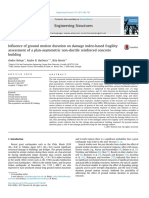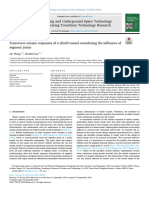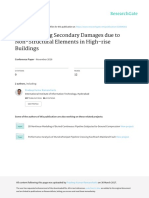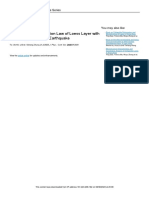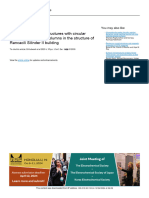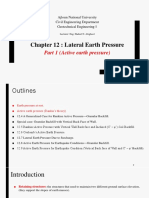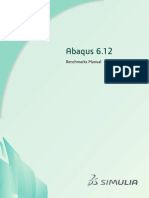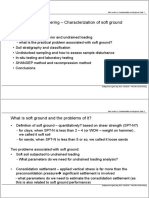Aci 318M - 14
Aci 318M - 14
Uploaded by
Ja VaCopyright:
Available Formats
Aci 318M - 14
Aci 318M - 14
Uploaded by
Ja VaOriginal Title
Copyright
Available Formats
Share this document
Did you find this document useful?
Is this content inappropriate?
Copyright:
Available Formats
Aci 318M - 14
Aci 318M - 14
Uploaded by
Ja VaCopyright:
Available Formats
Yu, et al.
Int J Earth Environ Sci 2017, 2: 147
https://doi.org/10.15344/2456-351X/2017/147
International Journal of
Earth & Environmental Sciences
Review Article Open Access
Investigation on Damage Mechanism of the Daikai Station Induced by
the Strong Kobe Earthquake
Haitao Yu1,2* and Xinxi Li3
1
Key Laboratory of Geotechnical and Underground Engineering of Ministry of Education, Tongji University, Shanghai 200092, China
2
Shanghai Municipal Engineering Design Institute (Group) Co., Ltd., Shanghai 200092, China
3
Department of Geotechnical Engineering, Tongji University, Shanghai 200092, China
Abstract Publication History:
The Daikai station, a cut and cover structure in the subway system in Kobe, collapsed during the Hyogo Received: November 02, 2017
ken-Nanbu earthquake of January 17, 1995 in Japan, which attracted significant attention on seismic design of Accepted: December 21, 2017
underground structures world widely. Based on literature review of published researches, dynamic numerical Published: December 23, 2017
analyses have been conducted to investigate the damage mechanism of the Daikai station subjected to the
strong earthquake. The equivalent linear model has been used for the soil to approximate the nonlinear Keywords:
dynamic behavior of the soil including the shear modulus and the increase of damping with strain. The
Concrete Damaged Plasticity model has been adopted to capture the damage evolution and progressive failure
The Daikai station, Collapse
of the subway station under seismic loadings. The influence of vertical motion on the seismic response of the
mechanism, Middle columns,
station is evaluated in the paper. A comparison between the numerical predictions and the damage reported
Seismic motion, Numerical
shows a good agreement. The results indicate that the middle columns are the most severely damage part
analysis
of the station and are mainly controlled by the horizontal ground motion. In contrast, the vertical seismic
motion can generally be neglected.
Introduction with the destruction position located at the connections between
the top and bottom of the column and the slab. Total length of about
It is generally believed that underground structures have a strong 110m was completely destroyed [5]. Other structural components also
seismic performance compared to surface structures because of the suffered various damages, such as the concrete of the side walls were
constrained effect of the surrounding ground [1]. Nevertheless, a spalled, and the wide cracks led to obvious leakage [6]. The maximum
number of underground structures have experienced significant subsidence of the national road above the subway was around 2.5m
damage during the 1995 Kobe earthquake, including subways, parking caused by the deformed top slab [5], as shown in Figure 1.
lots, tunnels and commercial streets. Most importantly, the strong
earthquake caused the collapse of the Daikai Station, a reinforced
concrete underground structure in the subway system in Kobe [2].
After few years, during the subsequent earthquakes, such as the Chi-
Chi earthquake in Taiwan in September 1999 and Turkey earthquake
in November 1999, a number of underground structures have also
suffered severe damage, some quite extensively [3]. The damage
provides sufficient evidence to suggest that the safety of underground
structures in seismically active areas is still an important issue, but not
well understood yet, or at least not well consider during design.
In this study, published researches on damage observation and
analysis of the Daikai station are firstly reviewed and summarized. Figure 1: The damage pattern of the Daikai station [4]
Based on the literature review, dynamic numerical analyses are
conducted to investigate the damage mechanism of the Daikai station. The collapse of the Daikai station was the first case of severe
The nonlinear dynamic behavior of the soil is approximated by the earthquake-induced damage to modern underground structure, and
equivalent linear model. The Concrete Damaged Plasticity model thus a number of researchers focused on the damage mechanism
is adopted to capture the damage evolution and progressive failure of the station in order to develop design theories and methods for
of the subway station under the strong earthquake. The dynamic practitioners. As observed from the damage of the Daikai station,
explicit method (central difference method) is employed to solve the the middle columns were the most seriously destroyed parts of the
dynamic problem. The influence of the vertical motion on seismic station. Thus, many researchers began to investigate the performance
responses of the station is evaluated and compared with that of the and failure mode of the middle columns. Yamato [7] conducted static
horizontal motion. Through the investigation, the goal of the paper is analysis and considered nonlinear relationship between the moment
to determine, or at least estimate, the causes and the mechanisms of *
Corresponding Author: Prof. Haitao Yu, Department of Geotechnical
damage observed at the Daikai station, which would be beneficial for Engineering, Tongji University, 1239 Siping Road, Shanghai 200092, China; E-mail:
seismic design of underground structures in future. yuhaitao@tongji.edu.cn
Literature Review Citation: Yu H, Li X (2017) Investigation on Damage Mechanism of the Daikai
Station Induced by the Strong Kobe Earthquake. Int J Earth Environ Sci 2: 145.
doi: https://doi.org/10.15344/2456-351X/2017/147
The Daikai Station, a cut-and-cover structure, was built between
1962 and 1964 [2]. It was located about 15 km from the epicenter of Copyright: © 2018 Yu et al. This is an open-access article distributed under the
the strong Kobe earthquake. During the earthquake, more than 30 terms of the Creative Commons Attribution License, which permits unrestricted
use, distribution, and reproduction in any medium, provided the original author
columns of the central section of the station completely collapsed, and source are credited.
Int J Earth Environ Sci IJEES, an open access journal
ISSN: 2456-351X Volume 2. 2017. 147
Citation: Yu H, Li X (2017) Investigation on Damage Mechanism of the Daikai Station Induced by the Strong Kobe Earthquake. Int J Earth Environ Sci 2: 145.
doi: https://doi.org/10.15344/2456-351X/2017/147
Page 2 of 10
and rotational angle at the end of the elements of the structure. It the response of the station. Nakamura [20] concluded that the damage
was concluded from the results that center columns failed due to of center columns depended on the stiffness of ground around the
the bending and shear failure of those columns. Based on the three- station. Uenishi [21] showed that a seismic wave with a specific
dimensional finite element analysis, Samata [8] revealed that the frequency could induce resonance of a column at midspan of the
shear failure of the middle column was prior to the flexural yielding station.
of the slabs and walls. An et al. [9] observed from numerical results
that the failure of the middle column was caused by its low shear In general, great efforts have been made in investigating the failure
capacity and poor ductility. Iwatate [10] summarized from shaking mode and the collapse mechanism of the Daikai station based on
table tests of the scaled subway station that the scaled model collapsed a series of numerical and experimental approaches. However, a
due to lack of the load carrying capacity against shear at the middle consensus on the collapse mechanism of the Daikai station has not
column. Parra-Montesinos [11] predicted a reasonable range of drifts been achieved yet. Moreover, only few investigations on the nonlinear
at which collapse was expected in the columns of the station by using seismic response of the station were addressed. As aforementioned
the Elwood-Moehle column collapse model. Huan [12] developed before, the aim of the paper is therefore to fulfill these forward
a 3D shock isolator composed of dash spring and lead rubber problems, that is, to determine the causes and the mechanisms of
beading for the middle column, and validated from 3D numerical damage observed at the Daikai station after a series of nonlinear
results that the isolator could markedly reduce the deformation numerical simulations, as addressed below.
and damage of the column when fixed at the ends of the column.
Numerical Model and Parameters
What is more interesting is that, strong vertical seismic motions The dimension of the Daikai station
were recorded during the Kobe earthquake [13]. However, limited
studies have investigated the effect of the vertical seismic motion on There were three sections for the Daikai station: the central section,
underground structures [14,15]. Iida [4] investigated that the damage the subway tunnels section and the access station section. The central
of the station due to vertical force was still unclear. Chen [16] used the section (see Figure 2), which was mainly damaged, was 17m wide and
substructure subtraction method and considered the soils above the 7.17m high. The wall thickness was 0.70m. The thicknesses of the top
station as an affiliated structure of the station. It was concluded that and bottom slab were 0.80m and 0.85m, respectively. The top slab was
the collapse of the columns of the Daikai station was induced by both located 4.8m below the ground surface. The middle columns had a
the horizontal and vertical vibrations. Based on the pushover analysis, rectangular cross section of 0.4m by 1.0m, spaced 3.5m between axes
Liu [17] indicated that the strong horizontal and vertical seismic loads in the longitudinal direction.
contributed to the failure of the subway station.
Material model for concrete structure
Other researchers investigated the damage mechanism of the Daikai
station from different views. Sakai [18] found that the frequency As well known, concrete is a complex multiphase composite
components of an input motion lower than 2Hz had a strong influence material. A number of constitutive models for the static and dynamic
on the relative displacement between the top and bottom slabs, and response of concrete have been proposed in the past [22, 23]. The
the effect of frequency components higher than 3Hz was negligible. Concrete Damaged Plasticity (CDP) model [24] developed by
Huo [19] investigated the load transfer mechanisms between the Lubliner [25], Lee and Fenves [26], was used to describe the nonlinear
underground structure and the surrounding soil and found that the behavior of concrete in this study. It uses two damage variables, the
relative stiffness between the structure and the degraded surrounding tensile damage factor dt and the compressive damage factor dc , to
ground and the frictional characteristics of the interface determined discount the elastic stiffness of concrete due to the increase of damage.
Figure 2: The central section of the Daikai station
Int J Earth Environ Sci IJEES, an open access journal
ISSN: 2456-351X Volume 2. 2017. 147
Citation: Yu H, Li X (2017) Investigation on Damage Mechanism of the Daikai Station Induced by the Strong Kobe Earthquake. Int J Earth Environ Sci 2: 145.
doi: https://doi.org/10.15344/2456-351X/2017/147
Page 3 of 10
If E0 is the initial elastic stiffness of concrete, the stress-strain The plastic strain under compression loading follows the
relations under uniaxial tension and compression loading are relationship (see Figure 4)
(1)
(4)
(2) Where and
Where σt and σc are the tensile and compressive stresses respectively, For the Daikai station, the design strength of the concrete was
while εt and εc are the tensile and compressive strains respectively. 23.52 MPa for the central columns and 20.58 MPa for other structural
components, while the strength of the specimens for the central
The plastic strain under tension loading follows the relationship columns was 39.7 MPa [4]. Table 1 shows the parameters used in the
(see Figure 3) CDP model.
(3) Material model for soil
Where and The ground surrounding the Daikai station is mainly composed
of Quaternary Holocene sand and Pleistocene clay. The nonlinear
Figure 3: The stress-strain relations of concrete under uniaxial tension loading [24].
Figure 4: The stress-strain relations of concrete under uniaxial compression loading [24].
Int J Earth Environ Sci IJEES, an open access journal
ISSN: 2456-351X Volume 2. 2017. 147
Citation: Yu H, Li X (2017) Investigation on Damage Mechanism of the Daikai Station Induced by the Strong Kobe Earthquake. Int J Earth Environ Sci 2: 145.
doi: https://doi.org/10.15344/2456-351X/2017/147
Page 4 of 10
dynamic behavior of the soil is approximated by the equivalent linear Analysis procedure
model. The parameters used in the model are referred to the test data
from Seed [27], as illustrated in Table 2 and Table 3. Dynamic explicit method [29], based on the central difference
method, is used to capture the dynamic and nonlinear behavior of
Boundary conditions and seismic inputs the soil-structure system, which is carried out using the program
ABAQUS. Test runs are carried out to determine the length of analysis
The discretization of both the soil and the concrete structure is and time step, and it is found that the above two parameters are
done with the eight-node hexahedral solid elements CPE4R, as adequate in capturing the major response.
shown in Figure 5. Perfect bonding is assumed between the subway
station and the soil. The lateral boundaries are taken in the model Two scenarios are considered in the numerical simulation:
as free boundaries. In the model the distance from the structure to horizontal motion only, in the X direction perpendicular to the subway
the lateral boundary is more than ten times the dimensions of the axis (see Figure 5a), is applied at the bottom of the discretization,
structure. The adequacy of the type of boundary and mesh size was while the displacement of the Z direction is fixed at the bottom; and
verified by running a number of preliminary numerical tests where the combination of the horizontal motion (X direction in Figure 5a)
the lateral boundaries of the discretization were placed at different and the vertical motion (Z direction in Figure 5a). This is done to
distances from the subway structure. It was decided that the size of investigate the effect of the vertical acceleration on the response of the
the discretization was acceptable when free-field conditions were subway station since for design that is often neglected.
recovered in the area between the structure and the boundaries.
Results and Discussion
The earthquake record that was relevant to the subway station
corresponded to that registered at the Kobe meteorological General response of the Daikai station
observatory. The ground motion imposed at the bottom of the model
with a depth of 30m is that of Figure 6. As observed from the figure, The general response of the Daikai station under the scenario of
the maximum acceleration in the horizontal direction was 0.4g and in
horizontal X motion only is discussed in this subsection.
the vertical direction, 0.15g [28].
Density/kg•m-3 Poisson’s ratio Young’s modulus/MPa Compressive yield stress/MPa Tensile yield stress/MPa
2500 0.2 3.35×10 4
39.8 3.4
Table 1: Parameters used in the CDP model for numerical calculations
Soil type depth/m Density/kg•m-3 Vs/m•s-1 Shear modulus/MPa Young’s modulus/MPa
Backfilled 2.20 1.80 188.0 62.03 180.03
Holocene clay 1.00 1.60 199.0 62.03 180.03
Holocene sand 5.80 1.80 183.0 62.03 180.03
Pleistocene clay 1.10 1.80 197.0 68.21 197.76
Pleistocene gravel 2.40 2.10 240.0 118.78 344.37
Pleistocene clay 4.75 1.80 228.0 91.53 265.38
Pleistocene gravel >10 2.10 453.0 430.32 1247.93
Table 2: Physical properties of soil layers [7]
γeff(%) lgγeff attenuation coefficient of shear modulus attenuation coefficient of damping
sand clay sand clay
≤1.0×10-4 -4.0 1.000 1.000 2.50 0.50
3.16×10-4 -3.5 0.913 0.984 2.50 0.80
1.00×10-3 -3.0 0.761 0.934 2.50 1.70
3.16×10 -3
-2.5 0.565 0.826 3.50 3.20
1.00×10-2 -2.0 0.400 0.656 4.75 5.60
3.16×10 -2
-1.5 0.261 0.443 6.50 10.0
1.00×10-1 -1.0 0.152 0.246 9.25 15.5
0.316 -0.5 0.076 0.115 13.8 21.0
1.00 0.0 0.037 0.049 20.0 24.6
3.16 0.5 0.013 0.049 26.0 24.6
≥10.00 1.0 0.004 0.049 29.0 24.6
Table 3: The nonlinear data of sand and clay [27]
Int J Earth Environ Sci IJEES, an open access journal
ISSN: 2456-351X Volume 2. 2017. 147
Citation: Yu H, Li X (2017) Investigation on Damage Mechanism of the Daikai Station Induced by the Strong Kobe Earthquake. Int J Earth Environ Sci 2: 145.
doi: https://doi.org/10.15344/2456-351X/2017/147
Page 5 of 10
Displacement responses Figure 7 illustrates that the relative displacements at the left side
wall and middle column are basically the same, with the peak value
Inertial force is the main factor for surface structures damaged in 2.15 cm and 2.17 cm respectively, occurred when time is 8.44s. They
an earthquake while displacement and strain are more significant are both caused by the shearing deformation of the surrounding
for underground structures [30]. Figure 7 shows the time history of ground.
relative displacement at the left side wall and middle column.
Figure 5: FE model of the Daikai Station.
Figure 6: The input horizontal and vertical acceleration
Figure 7: Time history of relative displacement between the top and the bottom of left side wall and middle column
Int J Earth Environ Sci IJEES, an open access journal
ISSN: 2456-351X Volume 2. 2017. 147
Citation: Yu H, Li X (2017) Investigation on Damage Mechanism of the Daikai Station Induced by the Strong Kobe Earthquake. Int J Earth Environ Sci 2: 145.
doi: https://doi.org/10.15344/2456-351X/2017/147
Page 6 of 10
Acceleration responses Stress responses
The horizontal motion at the bottom and the top of the station Figure 9-10 show the time history of major principal stress and
is shown in Figure 8. The peck acceleration of the bottom of the minor principal stress at 4 representative sites (top of middle column,
station is 0.61g, which is approximately 1.53 times of the peck input bottom of middle column, top of side wall, bottom of side wall). It is
acceleration. And the peck acceleration of the top of the station observed that the stress of the middle column is considerably larger
is 1.03g. It's 2.57 times larger than the peck input acceleration. It is than that of side wall, with the peak value (6.01 MPa) exceeding the
obviously that the acceleration responses of the station are amplified concrete tensile yield stress (3.4 MPa).
in various degrees, which is also a main factor for the station damaged
in the earthquake.
Figure 8: Time history of acceleration at the bottom and the top of the station
Figure 9: Time history of major principal stress
Figure 10: Time history of minor principal stress
Int J Earth Environ Sci IJEES, an open access journal
ISSN: 2456-351X Volume 2. 2017. 147
Citation: Yu H, Li X (2017) Investigation on Damage Mechanism of the Daikai Station Induced by the Strong Kobe Earthquake. Int J Earth Environ Sci 2: 145.
doi: https://doi.org/10.15344/2456-351X/2017/147
Page 7 of 10
Figure 11: Developed tensile damage zone in the subway station at different times.
Int J Earth Environ Sci IJEES, an open access journal
ISSN: 2456-351X Volume 2. 2017. 147
Citation: Yu H, Li X (2017) Investigation on Damage Mechanism of the Daikai Station Induced by the Strong Kobe Earthquake. Int J Earth Environ Sci 2: 145.
doi: https://doi.org/10.15344/2456-351X/2017/147
Page 8 of 10
The middle columns are subjected to large stress causing by shear The damage evolution of Dakai station is shown in Figure 11: (a)
force, axial force and bending moment. And the results obtained from the concrete of the top and bottom of the middle column begins to
the research indicate that they are the most severely damage part damage at time 4.80s; (b) when time is 4.98s, damage extends to the
among the subway structure because of the small cross-section area of entire cross-section of the middle column immediately so that the
the columns and no support constrains around them. top and bottom of the column lose tensile strength and horizontal
shear strength; (c) damage occurs at the junction regions between the
Damage evolution process walls and slabs at time 5.10s; (d) the entire cross-section of the side
walls damage completely at time 6.00s and the damage of the middle
In order to give an insight into the damage evolution process and column extends from the ends to the middle; (e) the top slab damage
mechanism of the Daikai station subjected to the earthquake, the completely at time 8.40s.
expansion of the tensile damage factor dt in the concrete structure
is plotted in Figure 11. Note that dt>0 means the concrete begins to It can be concluded that the collapse of the station attributes to the
damage while dt>1 means the concrete damage completely. damage of the middle column. The finding is consistent with the field
observations, Figure 1, of central columns of the station completely
collapsed and the damage zone located at both ends of the column
and the slab.
Figure 12: Time history of relative displacement between the top and bottom of middle
column under horizontal only and horizontal and vertical motion.
Figure 13: Time history of major principal stress of middle column under horizontal only and horizontal and
vertical motion
Int J Earth Environ Sci IJEES, an open access journal
ISSN: 2456-351X Volume 2. 2017. 147
Citation: Yu H, Li X (2017) Investigation on Damage Mechanism of the Daikai Station Induced by the Strong Kobe Earthquake. Int J Earth Environ Sci 2: 145.
doi: https://doi.org/10.15344/2456-351X/2017/147
Page 9 of 10
The effect of vertical motion References
Time history of relative displacement between the top and bottom 1. Ji Q, Yang L (2001) Seismic Damage and Restoration Measures of Subway.
of middle column under horizontal only and horizontal and vertical Journal of Catastrophology 02: 32-37.
seismic motion is shown in Figure 12. Compared with the effect of 2. EQE Summary Report (1995) The January 17, 1995 Kobe Earthquake.
horizontal motion, vertical motion has little effect on displacement 3. Wang WL, Wang TT, Su JJ, Lin CH, Seng CR, et al. (2001) Assessment
of the station. of damage in mountain tunnels due to the Taiwan Chi-Chi Earthquake.
Tunnelling and Underground Space Technology Incorporating Trenchless
Technology Research 16: 133-150.
Figure 13 shows the time history of major principal stress of middle
4. LIida H, Hiroto T, Yoshida N, Iwafuji M (1996) Damage to Daikai subway
column under horizontal only and horizontal and vertical motion. It station. Soils and Foundations, Special Issue 36: 283-300.
is obtained that the vertical seismic motion has a minor effect on the 5. JSEC, Report on the Hanshin-Awaji Earthquake, 1995, pp. 47-50.
seismic response of the subway station. And the dt caused by vertical
6. Zhuang HY, Cheng SG, Chen GX (2008) Numerical simulation and
seismic motion is almost zero all the time. Thus the horizontal seismic analysis of earthquake damages of Daikai metro station caused by Kobe
motion is the controlling factor affecting the column damage and the earthquake. Rock and Soil Mechanics 01: 245-250.
vertical seismic motion can generally be neglected. 7. Yamato T, Umehara T, Aoki H, Nakamura S, Ezaki J et al. (1996) Damage
to Daikai subway station, Kobe rapid transit system and estimation of its
reason. In Proceedings of Technical Conference on the Great Hanshin-
Conclusions Awaji Earthquake. JSCE, Tokyo 1996: 303-320
8. Samata S, Ohuchi H, Matsuda T (1997) A study of the damage of subway
The paper describes in detail the damage observed at the Daikai structures during the 1995 Hanshin-Awaji earthquake. Cement and
station, which was adversely affected by the strong Kobe earthquake, Concrete Composites 19: 223-239.
and presents a detailed dynamic numerical analysis of the station 9. An XH, Shawky AA, Maekawa K (1997) The collapse mechanism of
to reveal the causes and the mechanisms of damage. Evaluation of a subway station during the Great Hanshin Earthquake. Cement and
the damage observed has been done using a refined FEM model of Concrete Composites 19: 241-257.
the subway station and surrounding soils that includes non-linear 10. Iwatate T, Kobayashi Y, Kusu H, Rin K (2000) Investigation and shaking
table tests of subway structures of the Hyogoken-Nanbu earthquake. Proc.
material behavior of the concrete and the equivalent linear model of the 12WCEE.
for the soil. Two scenarios are considered in the simulations: seismic
11. Parra-Montesinos GJ, Bobet A, Ramirez JA (2006) Evaluation of Soil-
input motion in the horizontal transverse direction only, and seismic Structure Interaction and Structural Collapse in Daikai Subway Station
input motion in the horizontal transverse and vertical directions. This During Kobe Earthquake. ACI Structural Journal 103: 113-122.
is done separately to investigate the effect of the vertical accelerations 12. Huan Y, Liu J, Chen L (2009) 3D Seismic Response Study on Underground
on the response of the station. The simulations yield predictions that Structures Based on Damaged Plasticity Theory. International Conference
are consistent with the damage observed at the Daikai station. of the Associated Research Centers for Urban Underground Space.
13. Yang J (2000) Interpretation of Seismic Vertical Amplification Observed at
an Array Site. Bulletin of the Seismological Society of America 90: 275-285.
The results obtained from the research indicate that the middle
columns are the most severely damage part among the subway 14. Wang R Luo Q (1998) Analysis on the Damage to Underground Structure
and Tunnel in Kobe Are Caused by Hanshin Earthquake. Journal of
structure because of the small cross-section area of the columns and Catastrophology 02: 63-66.
no support constrains around them. The vertical seismic motion has 15. Kongai K, Kamiya H, Nishiyama S (2001) Deformation buildup in soils
a minor effect on the seismic response of the subway station and as during the Kobe earthquake of 1995. Seismic Fault-induced Failures 01:
a result, it can be neglected for seismic design. The seismic damage 81-90.
mechanism of underground structures is still under investigation. 16. Chen GX, Zhuang HY, Zhang JL (2004) Analysis on the Earthquake
Additional work is currently being taken to analyze more in detail Response of Subway Station Based on the Substructuring Subtraction
Method. Journal of Disaster Prevention and Miligation Engineering 24:
the response of the subway station and also the relative importance of 396-401.
other models for both the concrete and soil. To ensure the functionality
17. Liu J, Liu X (2008) Pushover analysis of Daikai subway station during
of existing underground structures and enable future underground the Osaka-Kobe earthquake in 1995. The 14th World Conference on
structures to withstand earthquake, further investigation of damages Earthquake Engineering.
of other structures such as connections between tunnels and subway 18. Sakai H, Nozu A (2002) Domiant frequency component of seismic wave
stations is necessary. for the damage of underground structure. The 11th Proceedings of Japan
earthquake engineering 1033-1038.
Competing Interests 19. Huo H, Bobet A, Fernández G, Ramírez J (2005) Load Transfer
Mechanisms between Underground Structure and Surrounding Ground:
Evaluation of the Failure of the Daikai Station. Journal of Geotechnical and
The authors declare that no competing interests exist. Geoenvironmental Engineering 131: 1522-1533.
20. Nakamura S (2010) Evaluation of Damage Mechanism of Subway Station
Acknowledgements Based on the Difference Damage Between Two Damaged Subway Stations
Due to the Earthquake. Proceedings of JSCE 654: 335-354.
21. Uenishi K, Sakurai S (2000) Characteristic of the vertical seismic waves
The research has been supported by the National Natural associated with the 1995 Hyogo-ken Nanbu (Kobe), Japan earthquake
Science Foundation of China (51678438), the Shanghai Rising- estimated from the failure of the Daikai Underground Station. Earthquake
Star Program (17QC1400500), and the Shanghai Committee of Engineering and Structural Dynamics 29: 813-821.
Science and Technology (16DZ1200302 & 16DZ1201904). The 22. Hsieh SS, Ting EC, Chen WF (1982) A plasticity fracture model for concrete.
authors acknowledge the support from the State Key Laboratory International Journal of Solids and Structures 18: 181-197.
for GeoMechanics and Deep Underground Engineering, China 23. Han DJ, Chen WF (1987) Constitutive modeling in analysis of concrete
University of Mining & Technology (SKLGDUEK1723) and the structures. Journal of Engineering Mechanics Division ASCE 113: 577-593.
Fundamental Research Funds for the Central Universities of China. 24. ABAQUS Inc (2010) Analysis User's Manual. Volume III: Materials.
Int J Earth Environ Sci IJEES, an open access journal
ISSN: 2456-351X Volume 2. 2017. 147
Citation: Yu H, Li X (2017) Investigation on Damage Mechanism of the Daikai Station Induced by the Strong Kobe Earthquake. Int J Earth Environ Sci 2: 145.
doi: https://doi.org/10.15344/2456-351X/2017/147
Page 10 of 10
25. Lubliner J, Oliver J, Oller S, Oñate E (1989) A plastic-damage model for
concrete. International Journal of Solids and Structures 25: 299-326.
26. Lee J, Fenves GL (1998) Plastic-damage model for cyclic loading of
concrete structures. Journal of Engineering Mechanics 124: 892-900.
27. Seed HB, Idriss IM (1970) Soil Moduli and Damping Factors for Dynamic
Response Analysis. Earthquake Engineering Research Center, University
of California, Berkeley, Report No. EERC 70-10.
28. Yoshida N, Iai S (1998) Nonlinear Site Response and Its Evaluation and
Prediction. Proceeding of the 2nd International Symposium on the Effect of
Surface Geology on Seismic Motion, Yokosuka, Japan 71-90.
29. ABAQUS Inc (2007) Explicit dynamic analysis. section 6.3.3 of ABAQUS
Analysis User's Manual.
30. Hashash YMA, Hook JJ, Schmidt B, Yao JIC (2001) Seismic design and
analysis of underground structures. Tunnelling and Underground Space
Technology 16: 247-293.
Int J Earth Environ Sci IJEES, an open access journal
ISSN: 2456-351X Volume 2. 2017. 147
You might also like
- Compile Timber Past YearDocument45 pagesCompile Timber Past YearEZZARYN ERRISHA FARAZASMADYNo ratings yet
- Pipe Support Span CalculationsDocument2 pagesPipe Support Span CalculationsktejankarNo ratings yet
- 1 s2.0 S088677981731204X MainDocument9 pages1 s2.0 S088677981731204X MainyhdphkhsumigdoxaweNo ratings yet
- 13 Ac EngDocument17 pages13 Ac EngRom NoelNo ratings yet
- Paperpdf 1369 Yue PDFDocument8 pagesPaperpdf 1369 Yue PDFPrasannaNo ratings yet
- (LU) Nonlinear Collapse Simulation of Daikai Subway in The 1995 Kobe Earthquake Necessity of Dynamic Analysis For A Shallow TunnelDocument13 pages(LU) Nonlinear Collapse Simulation of Daikai Subway in The 1995 Kobe Earthquake Necessity of Dynamic Analysis For A Shallow Tunnelhal9000_mark1No ratings yet
- Nonlinear Seismic Response and Damage of Reinforced Concrete DuctsDocument16 pagesNonlinear Seismic Response and Damage of Reinforced Concrete DuctsBridge&StructureNo ratings yet
- Seismic Response of Circular Tunnels in Jointed Rock: Jin-Kwon Yoo, Jeong-Seon Park, Duhee Park, and Seung-Won LeeDocument9 pagesSeismic Response of Circular Tunnels in Jointed Rock: Jin-Kwon Yoo, Jeong-Seon Park, Duhee Park, and Seung-Won LeeKarim AlKhatibNo ratings yet
- Fabozzi Et Al (2017) - Prediction of The Seismic Behavior of An Underground Railway Station and A Tunnel in NapoliDocument18 pagesFabozzi Et Al (2017) - Prediction of The Seismic Behavior of An Underground Railway Station and A Tunnel in NapoliYuamar BasarahNo ratings yet
- Soil Dynamics and Earthquake Engineering: Ngoc-Anh Do, Daniel Dias, Pierpaolo Oreste, Irini Djeran-MaigreDocument11 pagesSoil Dynamics and Earthquake Engineering: Ngoc-Anh Do, Daniel Dias, Pierpaolo Oreste, Irini Djeran-MaigrePaloma CortizoNo ratings yet
- Effect of Buried Depth On Seismic Response of Rectangular Underground Structures Considering The Influence of Ground LossDocument20 pagesEffect of Buried Depth On Seismic Response of Rectangular Underground Structures Considering The Influence of Ground Loss468484524No ratings yet
- b80f PDFDocument10 pagesb80f PDFMirza Waqar BaigNo ratings yet
- Seismic Analysis of ResidenceDocument20 pagesSeismic Analysis of ResidenceXplore EnggtechNo ratings yet
- Fbuil 07 676408Document14 pagesFbuil 07 676408karim khaledNo ratings yet
- Tunnelling and Underground Space Technology: SciencedirectDocument20 pagesTunnelling and Underground Space Technology: SciencedirectDidaBouchNo ratings yet
- Seismic Performance Evaluation of Concrete Gravity DamsDocument14 pagesSeismic Performance Evaluation of Concrete Gravity DamshamidNo ratings yet
- DownloadDocument17 pagesDownloadmk779900mkNo ratings yet
- Damage Analysis of Cut-And-Cover Tunnel Structures Under Seismic LoadingDocument19 pagesDamage Analysis of Cut-And-Cover Tunnel Structures Under Seismic LoadingnishantNo ratings yet
- Effect of Different Aspects of Multiple Earthquakes On The Nonlinear BehaviorDocument20 pagesEffect of Different Aspects of Multiple Earthquakes On The Nonlinear BehaviorAndrew YauNo ratings yet
- Soil Structure Interaction Under Dynamic LoadingDocument9 pagesSoil Structure Interaction Under Dynamic LoadingonurumanNo ratings yet
- Response of Out-Of-Plumb Structures in Earthquake: T. Masuno, G.A. Macrae & V.K. SadashivaDocument6 pagesResponse of Out-Of-Plumb Structures in Earthquake: T. Masuno, G.A. Macrae & V.K. SadashivaMagdy BakryNo ratings yet
- 1 s2.0 S1738573319302220 MainDocument14 pages1 s2.0 S1738573319302220 MainA KNo ratings yet
- Damage Assessment of RC Frame Structures Under Multi-EarthquakeDocument7 pagesDamage Assessment of RC Frame Structures Under Multi-Earthquake190203057No ratings yet
- Pushover Analysis of Underground Structures: Method and ApplicationDocument15 pagesPushover Analysis of Underground Structures: Method and Applicationaitezaz hassanNo ratings yet
- Displacement SpectraDocument33 pagesDisplacement SpectraGyorgy AdrienneNo ratings yet
- Research Article: Research On Collapse Process of Cable-Stayed Bridges Under Strong Seismic ExcitationsDocument19 pagesResearch Article: Research On Collapse Process of Cable-Stayed Bridges Under Strong Seismic ExcitationsSethu ReghuNo ratings yet
- Seismic Assessment of A Cable-Stayed Arch Bridge Under Three-Component Orthotropic Earthquake ExcitationDocument16 pagesSeismic Assessment of A Cable-Stayed Arch Bridge Under Three-Component Orthotropic Earthquake ExcitationJuan BravoNo ratings yet
- Response Analysis of Civil Engineering Structures Subjected To Earthquake MotionsDocument22 pagesResponse Analysis of Civil Engineering Structures Subjected To Earthquake MotionsAnonymous MRuU9jwKnlNo ratings yet
- Fukae Bridge Collapse (Kobe 1995) Revisited: New Insights: SciencedirectDocument18 pagesFukae Bridge Collapse (Kobe 1995) Revisited: New Insights: SciencedirectAmanNo ratings yet
- Engineering Structures: Andre Belejo, Andre R. Barbosa, Rita BentoDocument22 pagesEngineering Structures: Andre Belejo, Andre R. Barbosa, Rita BentoStructural SpreadsheetsNo ratings yet
- Dynamic Analysis of Subway Station Subjected To Internal Blast LoadingDocument8 pagesDynamic Analysis of Subway Station Subjected To Internal Blast LoadingManish ShashikantNo ratings yet
- Rossetto Et AlDocument21 pagesRossetto Et AlEunice FiecasNo ratings yet
- Magliulo 2014Document14 pagesMagliulo 2014Aashish regmiNo ratings yet
- Seismic Analyses of Long-Span Cable-Stayed Bridges Subjected To Near-Fault Pulse-Type Ground MotionsDocument8 pagesSeismic Analyses of Long-Span Cable-Stayed Bridges Subjected To Near-Fault Pulse-Type Ground MotionsSyarif AlNo ratings yet
- Dynamic AnalysisDocument12 pagesDynamic AnalysisTashreeq TahirNo ratings yet
- NAOSITE: Nagasaki University's Academic Output SITE: This Document Is Downloaded At: 2016-09-13T03:52:09ZDocument31 pagesNAOSITE: Nagasaki University's Academic Output SITE: This Document Is Downloaded At: 2016-09-13T03:52:09ZponjoveNo ratings yet
- Using Spectral Matched Records To Explore The Influence ofDocument9 pagesUsing Spectral Matched Records To Explore The Influence ofarnold.r.mendoNo ratings yet
- Detection of Beam End Fractures in Steel Members Based On - 2021 - EngineeringDocument10 pagesDetection of Beam End Fractures in Steel Members Based On - 2021 - EngineeringTONY VILCHEZ YARIHUAMANNo ratings yet
- Numerical Investigation of Seismic Isolation Layer PerformanceDocument18 pagesNumerical Investigation of Seismic Isolation Layer PerformanceassogbaneurickNo ratings yet
- ICRAGEE2020 003 Original v1Document2 pagesICRAGEE2020 003 Original v1Asad HafudhNo ratings yet
- 1 s2.0 S0267726116301415 MainDocument9 pages1 s2.0 S0267726116301415 MainyhdphkhsumigdoxaweNo ratings yet
- Study On Building Structures With Sloping Ground Under Seismic and Wind Load ConditionsDocument4 pagesStudy On Building Structures With Sloping Ground Under Seismic and Wind Load ConditionsEditor IJTSRDNo ratings yet
- Alametal. 2019 Multi HazardEarthquake TsunamiStructuralFragiliDocument9 pagesAlametal. 2019 Multi HazardEarthquake TsunamiStructuralFragiliLoki PagcorNo ratings yet
- 1 s2.0 S0886779823004431 MainDocument17 pages1 s2.0 S0886779823004431 Mainericdhy777No ratings yet
- 4 Seismic Behavior of Underground Structures and Site ResponseDocument7 pages4 Seismic Behavior of Underground Structures and Site ResponseDennis NarteNo ratings yet
- Parametric Study of The Earth Dam's Behavior Subjected To EarthquakeDocument15 pagesParametric Study of The Earth Dam's Behavior Subjected To EarthquakeMaxMaximumNo ratings yet
- Structures: Sunil Thapa, Yadin Shrestha, Dipendra GautamDocument11 pagesStructures: Sunil Thapa, Yadin Shrestha, Dipendra GautamTanjil MominNo ratings yet
- ICE Tsunami Journal Article Jun2016Document29 pagesICE Tsunami Journal Article Jun2016Yashintha PandukaNo ratings yet
- Seismic Design and Analysis of Underground StructuresDocument47 pagesSeismic Design and Analysis of Underground Structuresfoush basha100% (2)
- Structural Response of Lattice Steel Masts For Seismic LoadingDocument7 pagesStructural Response of Lattice Steel Masts For Seismic LoadingKamiran MuhammadNo ratings yet
- 2-4 - Gullapalli Ramya-F - 53Document11 pages2-4 - Gullapalli Ramya-F - 53neeta rautelaNo ratings yet
- Zhang 2023 J. Phys. Conf. Ser. 2449 012021Document12 pagesZhang 2023 J. Phys. Conf. Ser. 2449 012021RobertoNo ratings yet
- Capilleri Et Al 2019 Static and Dynamic Analysis of Two Mechanically Stabilized Earth WallsDocument16 pagesCapilleri Et Al 2019 Static and Dynamic Analysis of Two Mechanically Stabilized Earth WallsGuruNo ratings yet
- 1 s2.0 S0886779816307751 MainDocument16 pages1 s2.0 S0886779816307751 MainMert GőkdoğanNo ratings yet
- Structures With Circular and Square ColumnsDocument12 pagesStructures With Circular and Square ColumnsKo ShineNo ratings yet
- Effects of BackfillDocument13 pagesEffects of BackfillAyşegül Durmuş DemirNo ratings yet
- Research ArticleDocument14 pagesResearch ArticleAnupam Gowda M.NNo ratings yet
- 1 s2.0 S0267726118313848 MainDocument16 pages1 s2.0 S0267726118313848 Main齐鸳No ratings yet
- 1-s2.0-S0029801821012580-Main Experimental Wave and SeismicDocument19 pages1-s2.0-S0029801821012580-Main Experimental Wave and Seismicegemen gökalpNo ratings yet
- Research Article: Seismic Performance Evaluation of Building-Damper System Under Near-Fault EarthquakeDocument21 pagesResearch Article: Seismic Performance Evaluation of Building-Damper System Under Near-Fault Earthquakeutsav_koshtiNo ratings yet
- Chapter 12: Lateral Earth PressureDocument61 pagesChapter 12: Lateral Earth PressureAlaa TelfahNo ratings yet
- AISC 360-05 Example 001Document7 pagesAISC 360-05 Example 001Ronald SotoNo ratings yet
- Brittleness and Rock Strength of The Bakken Formation, Williston Basin, North DakotaDocument20 pagesBrittleness and Rock Strength of The Bakken Formation, Williston Basin, North DakotaJimmy100% (1)
- Beam Design With Deflection CheckDocument7 pagesBeam Design With Deflection CheckDevesh GuptaNo ratings yet
- AISC-342 Seismic Provisions For Evaluation and Retrofit of Existing Structural Steel Buildings Public ReviewDocument149 pagesAISC-342 Seismic Provisions For Evaluation and Retrofit of Existing Structural Steel Buildings Public Reviewjackcan501No ratings yet
- Flexure and Shear Interaction in Steel I-GirdersDocument14 pagesFlexure and Shear Interaction in Steel I-GirderswrayroNo ratings yet
- A Simple Model For Pushover Analysis of Masonry Walls With Irregular TextureDocument12 pagesA Simple Model For Pushover Analysis of Masonry Walls With Irregular TextureGiuseppe Alfredo CundariNo ratings yet
- Chapter 3 (MEC681) - MHI PDFDocument71 pagesChapter 3 (MEC681) - MHI PDFمحمد فائزNo ratings yet
- R-Kem II Masonry - OptDocument7 pagesR-Kem II Masonry - OptGnomo GnominNo ratings yet
- Benchmarks PDFDocument1,738 pagesBenchmarks PDFPiseth Heng100% (1)
- Anchor Bolt DesignDocument3 pagesAnchor Bolt DesignDanielNo ratings yet
- RCC DesignDocument39 pagesRCC DesignMariappan .PNo ratings yet
- SOM Cycle Test 1 Answer KeyDocument2 pagesSOM Cycle Test 1 Answer KeySelvaraj GNo ratings yet
- MECA 332 Mechatronics Component Design: Week 8 Ps - IvDocument19 pagesMECA 332 Mechatronics Component Design: Week 8 Ps - IvArda GunayNo ratings yet
- Distribution of Shear Force in Concrete Slabs: Poja Shams HakimiDocument94 pagesDistribution of Shear Force in Concrete Slabs: Poja Shams HakimiAndrey SemjonovNo ratings yet
- HILTI ANALYSIS Based On Tensile and Shear (Hitungan Manual Sendiri)Document3 pagesHILTI ANALYSIS Based On Tensile and Shear (Hitungan Manual Sendiri)inti lestariNo ratings yet
- Uponor Dop Klett CPR 20 Ic 251 V 001Document3 pagesUponor Dop Klett CPR 20 Ic 251 V 001jamppajoo2No ratings yet
- Structural Instability - SHT 3Document5 pagesStructural Instability - SHT 3scribNo ratings yet
- Large-Scale Experimental Lateral Torsional Buckling Tests of Welded I-Section MembersDocument20 pagesLarge-Scale Experimental Lateral Torsional Buckling Tests of Welded I-Section Membersjackcan501No ratings yet
- Mechanics of Materials Formulas and Problems Engineering Mechanics 2 by - by WWW - LearnEngineering.inDocument219 pagesMechanics of Materials Formulas and Problems Engineering Mechanics 2 by - by WWW - LearnEngineering.inHữu Danh Nguyễn100% (1)
- Aat 1Document4 pagesAat 1HARNITH EVILLNo ratings yet
- Unit-4 PPT (Steel Codes)Document39 pagesUnit-4 PPT (Steel Codes)Pratik ShelarNo ratings yet
- Controlled Modulus Column C Plomteux Amp P Liausu PDF FreeDocument6 pagesControlled Modulus Column C Plomteux Amp P Liausu PDF FreeGabriel ColoradoNo ratings yet
- Project: Document No Date 21-05-2022 Designed Checked Description Visakhapatnam Port TrustDocument1 pageProject: Document No Date 21-05-2022 Designed Checked Description Visakhapatnam Port Trustkeerthivasan_mrvNo ratings yet
- SDOF - Forced VibrationsDocument28 pagesSDOF - Forced Vibrationsebrahimmousa9999No ratings yet
- 2018 - SGE - Topic 2 - Characterization of Soft GroundDocument24 pages2018 - SGE - Topic 2 - Characterization of Soft GroundJohnNo ratings yet
- Seismic Design To S16-09 PDFDocument13 pagesSeismic Design To S16-09 PDFDarryn McCormickNo ratings yet
- 2 T 2Document14 pages2 T 2PuligalNo ratings yet





























